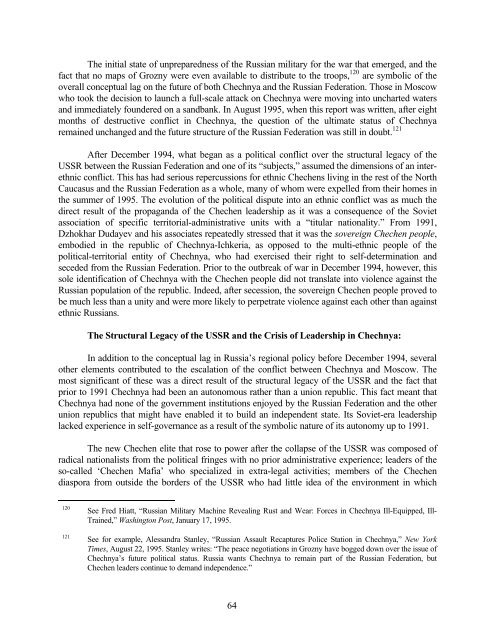RUSSIA'S TINDERBOX - Belfer Center for Science and International ...
RUSSIA'S TINDERBOX - Belfer Center for Science and International ...
RUSSIA'S TINDERBOX - Belfer Center for Science and International ...
Create successful ePaper yourself
Turn your PDF publications into a flip-book with our unique Google optimized e-Paper software.
The initial state of unpreparedness of the Russian military <strong>for</strong> the war that emerged, <strong>and</strong> the<br />
fact that no maps of Grozny were even available to distribute to the troops, 120 are symbolic of the<br />
overall conceptual lag on the future of both Chechnya <strong>and</strong> the Russian Federation. Those in Moscow<br />
who took the decision to launch a full-scale attack on Chechnya were moving into uncharted waters<br />
<strong>and</strong> immediately foundered on a s<strong>and</strong>bank. In August 1995, when this report was written, after eight<br />
months of destructive conflict in Chechnya, the question of the ultimate status of Chechnya<br />
remained unchanged <strong>and</strong> the future structure of the Russian Federation was still in doubt. 121<br />
After December 1994, what began as a political conflict over the structural legacy of the<br />
USSR between the Russian Federation <strong>and</strong> one of its “subjects,” assumed the dimensions of an interethnic<br />
conflict. This has had serious repercussions <strong>for</strong> ethnic Chechens living in the rest of the North<br />
Caucasus <strong>and</strong> the Russian Federation as a whole, many of whom were expelled from their homes in<br />
the summer of 1995. The evolution of the political dispute into an ethnic conflict was as much the<br />
direct result of the propag<strong>and</strong>a of the Chechen leadership as it was a consequence of the Soviet<br />
association of specific territorial-administrative units with a “titular nationality.” From 1991,<br />
Dzhokhar Dudayev <strong>and</strong> his associates repeatedly stressed that it was the sovereign Chechen people,<br />
embodied in the republic of Chechnya-Ichkeria, as opposed to the multi-ethnic people of the<br />
political-territorial entity of Chechnya, who had exercised their right to self-determination <strong>and</strong><br />
seceded from the Russian Federation. Prior to the outbreak of war in December 1994, however, this<br />
sole identification of Chechnya with the Chechen people did not translate into violence against the<br />
Russian population of the republic. Indeed, after secession, the sovereign Chechen people proved to<br />
be much less than a unity <strong>and</strong> were more likely to perpetrate violence against each other than against<br />
ethnic Russians.<br />
The Structural Legacy of the USSR <strong>and</strong> the Crisis of Leadership in Chechnya:<br />
In addition to the conceptual lag in Russia’s regional policy be<strong>for</strong>e December 1994, several<br />
other elements contributed to the escalation of the conflict between Chechnya <strong>and</strong> Moscow. The<br />
most significant of these was a direct result of the structural legacy of the USSR <strong>and</strong> the fact that<br />
prior to 1991 Chechnya had been an autonomous rather than a union republic. This fact meant that<br />
Chechnya had none of the government institutions enjoyed by the Russian Federation <strong>and</strong> the other<br />
union republics that might have enabled it to build an independent state. Its Soviet-era leadership<br />
lacked experience in self-governance as a result of the symbolic nature of its autonomy up to 1991.<br />
The new Chechen elite that rose to power after the collapse of the USSR was composed of<br />
radical nationalists from the political fringes with no prior administrative experience; leaders of the<br />
so-called ‘Chechen Mafia’ who specialized in extra-legal activities; members of the Chechen<br />
diaspora from outside the borders of the USSR who had little idea of the environment in which<br />
120 See Fred Hiatt, “Russian Military Machine Revealing Rust <strong>and</strong> Wear: Forces in Chechnya Ill-Equipped, Ill-<br />
Trained,” Washington Post, January 17, 1995.<br />
121 See <strong>for</strong> example, Aless<strong>and</strong>ra Stanley, “Russian Assault Recaptures Police Station in Chechnya,” New York<br />
Times, August 22, 1995. Stanley writes: “The peace negotiations in Grozny have bogged down over the issue of<br />
Chechnya’s future political status. Russia wants Chechnya to remain part of the Russian Federation, but<br />
Chechen leaders continue to dem<strong>and</strong> independence.”<br />
64
















